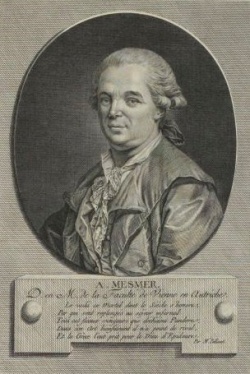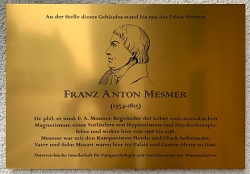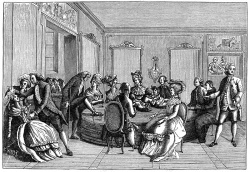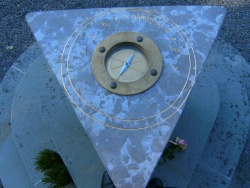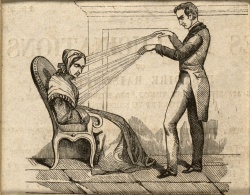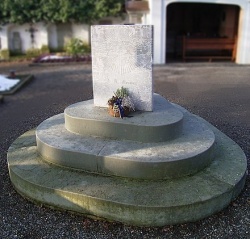Franz Anton Mesmer: Difference between revisions
No edit summary |
No edit summary |
||
| Line 62: | Line 62: | ||
<blockquote>'''Mesmer, Friedrich Anton'''. The famous physician who rediscovered and applied practically that magnetic fluid in man which was called animal magnetism and since then [[ Mesmerism]]. He was born in Schwaben, in 1734 and died in 1815. He was an initiated member of the Brotherhoods of the Fratres Lucis and of [[Brotherhood of Luxor|Lukshoor (or Luxor)]], or the Egyptian Branch of the latter. It was the Council of “Luxor” which selected him — according to the orders of the [[Brotherhood of Adepts|“Great Brotherhood”]] — to act in the XVIIIth century as their usual pioneer, sent in the last quarter of every century to enlighten a small portion of the Western nations in occult lore. It was [[Count de Saint Germain|St. Germain]] who supervised the development of events in this case; and later [[Cagliostro]] was commissioned to help, but having made a series of mistakes, more or less fatal, he was recalled. Of these three men who were at first regarded as quacks, Mesmer is already vindicated. The justification of the two others will follow in the next century. Mesmer founded the “Order of Universal Harmony” in 1783, in which presumably only animal magnetism was taught, but which in reality expounded the tenets of Hippocrates, the methods of the ancient Asclepieia, the Temples of Healing, and many other occult sciences.<ref>Helena Petrovna Blavatsky, ''The Theosophical Glossary'' (Krotona, CA: Theosophical Publishing House, 1973), 213-214.</ref></blockquote> | <blockquote>'''Mesmer, Friedrich Anton'''. The famous physician who rediscovered and applied practically that magnetic fluid in man which was called animal magnetism and since then [[ Mesmerism]]. He was born in Schwaben, in 1734 and died in 1815. He was an initiated member of the Brotherhoods of the Fratres Lucis and of [[Brotherhood of Luxor|Lukshoor (or Luxor)]], or the Egyptian Branch of the latter. It was the Council of “Luxor” which selected him — according to the orders of the [[Brotherhood of Adepts|“Great Brotherhood”]] — to act in the XVIIIth century as their usual pioneer, sent in the last quarter of every century to enlighten a small portion of the Western nations in occult lore. It was [[Count de Saint Germain|St. Germain]] who supervised the development of events in this case; and later [[Cagliostro]] was commissioned to help, but having made a series of mistakes, more or less fatal, he was recalled. Of these three men who were at first regarded as quacks, Mesmer is already vindicated. The justification of the two others will follow in the next century. Mesmer founded the “Order of Universal Harmony” in 1783, in which presumably only animal magnetism was taught, but which in reality expounded the tenets of Hippocrates, the methods of the ancient Asclepieia, the Temples of Healing, and many other occult sciences.<ref>Helena Petrovna Blavatsky, ''The Theosophical Glossary'' (Krotona, CA: Theosophical Publishing House, 1973), 213-214.</ref></blockquote> | ||
[[William Q. Judge]], wrote that Mesmer came out with his discoveries as agent, in fact - thought perhaps, without disclosing those behind him – of certain brotherhoods to which he belonged. His promulgations were in the last quarter of the century, just as those of the [[Theosophical Society]] were begun in 1875, and what he did was all that could be done at that time. <ref>Judge, William. <i>Mesmerism and Hypnotism</i>. William Q. Judge Series, No. 16. The Theosophy Company. Pages 1-2; the article was originally published in <i>Lucifer</i> in May 1892. </ref> | [[William Q. Judge]], wrote that Mesmer came out with his discoveries as agent, in fact - thought perhaps, without disclosing those behind him – of certain brotherhoods to which he belonged. His promulgations were in the last quarter of the century, just as those of the [[Theosophical Society]] were begun in 1875, and what he did was all that could be done at that time. <ref>Judge, William. <i>Mesmerism and Hypnotism</i>. William Q. Judge Series, No. 16. The Theosophy Company. Pages 1-2; the article was originally published in <i>Lucifer</i> in May 1892. It is also available online: https://www.theosociety.org/pasadena/theos/v12n01p07_mesmerism.htm</ref> | ||
William Judge believed that there was an actual fluid thrown off by the mesmerizer and wrote that those who can see into the plane to which it belongs assert its existence as a subtle form of matter. This fluid is composed in part of the astral substance around everyone, and in part of the physical atoms in a finely divided state. He continues <blockquote>”By some this astral substance is called aura. But that word is indefinite, as there are many sorts of aura and many degrees of its expression. […]This aura, then, is thrown off by the mesmerizer upon his subject, and is received by the latter in a department of his inner constitution, never described by any Western experimenters, because they know nothing of it. It wakes up certain inner and non-physical divisions of the person operated on, causing a change of relation between the various and numerous sheaths surrounding the inner man, and making possible different degrees of intelligence and of clairvoyance and the like. It has no influence whatsoever on the Higher Self, which it is impossible to reach by such means. […]When the hypnotic or mesmerized state is complete — and often when it is partial — there is an immediate paralyzing of the power of the body to throw its impressions, and thus modify the conceptions of the inner being. In ordinary waking life every one, without being able to disentangle himself, is subject to the impressions from the whole organism; that is to say, every cell in the body, to the most minute, has its own series of impressions and recollections, all of which continue to impinge on the great register, the brain, until the impression remaining in the cell is fully exhausted. And that exhaustion takes a long time. Further, as we are adding continually to them, the period of disappearance of impression is indefinitely postponed. Thus, the inner person is not able to make itself felt. But, in the right subject, those bodily impressions are by mesmerism neutralized for the time, and at once another effect follows, which is equivalent to cutting the general off from his army and compelling him to seek other means of expression." <ref>Judge, William. <i>Mesmerism and Hypnotism</i>. William Q. Judge Series, No. 16. The Theosophy Company. Pages 3-4; the article was originally published in <i>Lucifer</i> in May 1892. It is also available online: https://www.theosociety.org/pasadena/theos/v12n01p07_mesmerism.htm</ref></blockquote> | |||
==Mesmer’s Legacy== | ==Mesmer’s Legacy== | ||
Revision as of 14:53, 14 January 2021
Franz Anton Mesmer (May 23, 1734 – March 5, 1815), sometimes referred to as Friedrich Anton Mesmer, was a German physician with an interest in astronomy, who theorized that there was a natural energetic transference that occurred between all animate and inanimate objects that he called "animal magnetism". His methods were of considerable interest to Theosophists.
While he did not seem to be aware of the psychological implications of the power of suggestions on the human psyche, he paved the way for the discovery of hypnosis and for a scientific awareness of the subconscious mind and its functions. [1]
His followers adored him as a charismatic healer, and he repelled critics all the more because he surrounded himself with an aura of the supernatural.
Early Years
Franz Anton Mesmer, the third of nine children, was born on May 23, 1734 in Iznang, a small German village in the parish of Weiler on Lake Constance, close to the Swiss border. His father, Anton Mesmer, has been described as a simple and religious man. He was a forester employed by the Archbishop of Constance. His mother, Marie Ursula, the daughter of a locksmith, was kind and patient. She wanted her son to enter the priesthood but accepted his refusal. Franz Anton Mesmer might have inherited her almost inordinate patience. [2]
He loved nature and exhibited a special affection for water [3]; he seemed to have had a reflective nature as a boy and probably spent a lot of time alone. His pastoral upbringing might have contributed to his great sense of serenity and his obvious contact with himself, his inner life, and nature. [4]
One of his biographers wrote about the “powerful magnetic influence” that Mesmer contained within himself:
Through this life, in the bosom of free nature, he appears even whilst still a child to have drawn towards himself a natural power unpossessed by the dwellers by the fire-side, a power which appears to delight to flow into those who maintain a many-sided intercourse and struggle with nature…In such persons is discovered the development of a special sense and of a special power which in his latter life continue to develop itself in Mesmer, and which he, as so-called Magnetism, first recognized, and as a means of healing carefully examined and made known. [5]
After a childhood spent close to nature, he attended elementary school starting at the age of eight, went to the Jesuit college in Constance between the ages of 12 and 16 and then to the Jesuit University in Dillingen until he was twenty. After that, starting in 1754, Mesmer studied theology and canon law at the Bavarian University of Ingolstadt (later LMU in Munich) with a doctorate in philosophy. He was still not content and decided to go to Vienna to study medicine. [6][7]
His time in Vienna
From 1759 he studied medicine at the University of Vienna. Among his teachers in Vienna were Gerard van Swieten, Anton von Stoerck and Anton de Haen. He graduated in 1766 as Dr. med. with the dissertation "De planetarum influxu", in which he laid the foundations for his later system of animal magnetism.
With his medical degree secured, Mesmer began courting Maria Anna von Posch, recently widowed, who had a son, was ten years older than him, and extremely wealthy. The couple married on January 10, 1768, and moved into a mansion in Vienna, bought for the couple by Maria's father. [8] During this pleasant period Mesmer frequently entertained and played music with Hayden and Mozart. When Mozart offered his first opera for performance at age twelve, the Director of the Imperial Opera refused to perform it on the grounds that no one of his age could have written it. Mesmer immediately arranged for the work to be performed in his own theatre. In gratitude for his friendship, Mozart paid a permanent musical compliment to Mesmer in Cosi Fan Tutti. Mesmer had met Wolfgang Mozart through is father Leopold Mozart who had come to him for treatment. [9]However, this marriage appears to have been no source of comfort to him and they soon separated. [10]
At the time that the dissertation was written, Mesmer’s thesis aroused no controversy, and at the age of 33, he went on to found a perfectly conventional practice in Vienna. As he approached his forties, however, he found himself increasingly dissatisfied with the approach to medicine that was current at the time – a combination of bleeding, purgatives and opiates that was often more painful and terrifying than the conditions it sought to treat.[11]
During his years of medical practice he came upon his new art of healing through observing the origin, the form, and the career of diseases in connection with the great changes in our solar system and the universe; in other words, in connection with what he termed Universal Magnetism. He sought for this magnetism originally in electricity and subsequently in mineral magnetism. He made use of the magnet for healing at first in 1772. He was led to this discovery by the astronomer Father Hell. However, he used the magnet simply as a conductor from his own organism through his hands; and by this means brought forth remarkable cures. [12][13]
In 1775 Mesmer shared his discovery of animal magnetism with physicians and scientific academies, inviting their comments but the only reply was dismissive. He then tried to demonstrate the treatment’s success but was denounced publicly. [14]
Mesmer’s taste for theatre and showmanship may well have contributed to the hostile reception he received from the medical establishment of the day. His life and career became dogged with controversy. The most famous case involved the curing of the concert pianist Maria-Theresa Paradis of psychosomatic blindness. [15]Mesmer’s apparent success was followed by accusations from a prominent physician, who declared Mesmer a charlatan; Maria’s father, who feared audiences would lose interest if his daughter were cured, and Maria herself, who was irritated by the constant testing and who struggled with her musical performance. In the end her family reported that she was still blind. [16]
Discredited and derided in Vienna, Mesmer left for Paris in January 1778. [17]
His time in Paris
The City of Light seemed willing to embrace Mesmer's novel style of treatment. Establishing a practice in the luxurious Hôtel de Bouillon, the charismatic Mesmer soon found himself inundated with as many as 20 patients a day. [18]
His practice continued to swell. By 1780 it had grown so large that he would treat at least 200 patients a day in groups. Outbreaks of mass-hysteria were frequent during these treatments. The newspapers talked of Mesmeromania sweeping through the city. During that time Mesmer grew enormously wealthy.[19]Because Mesmer could not treat patients individually, he had come up with an idea. He had realized that water and glass could hold magnetism just like a battery. He set up tubs – called baquets in Paris – so large that 20 people could sit around them and then he magnetized the water. The people were sitting around these tubs and held on to a rod. The patients put the rod on the part of their body which was sick. He had several tubs and since he also wanted to treat the poor there was one tub in the back yard which was used by them. Mesmer even magnetized trees. [20]
After Mesmer published A History of the Discovery of Animal Magnetism in 1779, in which he recounted his experiments, and appended to it twenty-seven propositions [21], he moved for a while to Spa in eastern Belgium where he established a free clinic treating the poor gratuitously. His enemies hated him for his single-minded pursuit of truth; his friends were attracted to him by his personal qualities of heart and head. Many of his patients followed him to Spa. Friends convinced him to move back to Paris in 1781 and helped Mesmer to establish centers of magnetic healing throughout France. The “Societies of Harmony” were hospitals in which students of magnetic healing might study and poor patients were received gratis. [22]
However, he again attracted the antagonism of the medical profession, and in 1784 King Louis XVI appointed a commission of scientists and physicians to investigate Mesmer’s methods; among the commission’s members were the American inventor and statesman Bemjamin Franklin and the French chemist Antoine-Laurent Lavoisier. They reported that Mesmer was unable to support his scientific claims, and the mesmerist movement thereafter declined. [23]
After the French Academy committee passed sentence on the subject, condemning it in substance, mesmerism fell into disrepute, but was revived in America by many persons who adopted different names for their work and wrote books on it. [24]
Mesmer’s Last Years
After leaving Paris, Mesmer didn’t hang around long in any one place. He spent time in various locations in France, Germany, Great Britain, Austria, and Switzerland. He returned to Vienna in 1793 only to suffer the indignity of being deported from the city. The reason given was that his political views were suspicious. [25]
Mesmer retired to Frauenfeld and later to Constance. In 1814 he made his home at a farmhouse in the village of Reidetswiller. Afterwards he moved to Meersburg where he resided until his death. His last years were happy and peaceful and was able to satisfy his love of music. He passed away peacefully on March 5th, 1815 after feeling unwell for about two weeks. [26]
Mesmer wished to be interred very simply, but the people of Meersburg disregarded his wishes. Clergy and citizens united in giving him a ceremonious funeral and a monument was erected by his Berlin admirers and disciples. [27]
Mesmer’s grave is in a Catholic cemetery in Meersburg, Germany. There is nothing religious about his tombstone. It’s a three-sided obelisk. On one side is a pyramid with an eye, on one side is a drawing of the planets moving around the sun, and on one side is a torch. The only thing that could be religious about it is that it’s on three steps, and the obelisk and the steps are three-sided. [28]
Mesmerism
Mesmerism is the name given to an art, or the exhibition of a power to act upon others and the facility to be acted upon, which actually long antedate the days of Anton Mesmer. Another name of some of its phenomena is Hypnotism, and still another is Magnetism. Anton Mesmer gave greater publicity in the Western world to the subject than any other person and thus his name is still attached to it due to his experiments and cures. As mentioned below, H. P. Blavatsky pointed out that he was only a rediscoverer. The whole subject had been explored long before his time – indeed many centuries anterior to the rise of civilization in Europe. [29]
In his doctoral dissertation Mesmer asserted that the gravitational force of the planets, sun, and moon also affected the human body. [30]After his encounter with Father Hell, Mesmer revised his “animal gravitation” theory to one of animal magnetism. This universal force was not external gravitation but rather an internal force. Mesmer began to base his medical practice on his belief that an invisible fluid ran through all living things. Disease resulted when the fluid’s flow became blocked. Health could be restored through contact with a conductor of animal magnetism. The magnets in Father Hell’s therapy were superfluous Mesmer argued as Mesmer himself or any object that he magnetized could restore the flow. [31]Thus, Mesmer called this animal magnetism because it works not only with metal, but also by the mere laying on of hands or so-called air streams. [32] He further proposed that this force directly enters the substance of the nerves in a movement of ebb and flow. Consequently, this principle could cure nervous diseases directly and other diseases indirectly. [33][34]
Mesmer espoused a view of mutual influence between bodies (for example human, animal, plant and “heavenly” bodies etc.). In regard to the fluid he developed in Theory of the World his fundamental idea that there are two created principles in the universe: matter and movement (the one uncreated principle being God). [35][36]
Theosophists about Franz Anton Mesmer
H. P. Blavatsky wrote:
Mesmer, Friedrich Anton. The famous physician who rediscovered and applied practically that magnetic fluid in man which was called animal magnetism and since then Mesmerism. He was born in Schwaben, in 1734 and died in 1815. He was an initiated member of the Brotherhoods of the Fratres Lucis and of Lukshoor (or Luxor), or the Egyptian Branch of the latter. It was the Council of “Luxor” which selected him — according to the orders of the “Great Brotherhood” — to act in the XVIIIth century as their usual pioneer, sent in the last quarter of every century to enlighten a small portion of the Western nations in occult lore. It was St. Germain who supervised the development of events in this case; and later Cagliostro was commissioned to help, but having made a series of mistakes, more or less fatal, he was recalled. Of these three men who were at first regarded as quacks, Mesmer is already vindicated. The justification of the two others will follow in the next century. Mesmer founded the “Order of Universal Harmony” in 1783, in which presumably only animal magnetism was taught, but which in reality expounded the tenets of Hippocrates, the methods of the ancient Asclepieia, the Temples of Healing, and many other occult sciences.[37]
William Q. Judge, wrote that Mesmer came out with his discoveries as agent, in fact - thought perhaps, without disclosing those behind him – of certain brotherhoods to which he belonged. His promulgations were in the last quarter of the century, just as those of the Theosophical Society were begun in 1875, and what he did was all that could be done at that time. [38]
William Judge believed that there was an actual fluid thrown off by the mesmerizer and wrote that those who can see into the plane to which it belongs assert its existence as a subtle form of matter. This fluid is composed in part of the astral substance around everyone, and in part of the physical atoms in a finely divided state. He continues
”By some this astral substance is called aura. But that word is indefinite, as there are many sorts of aura and many degrees of its expression. […]This aura, then, is thrown off by the mesmerizer upon his subject, and is received by the latter in a department of his inner constitution, never described by any Western experimenters, because they know nothing of it. It wakes up certain inner and non-physical divisions of the person operated on, causing a change of relation between the various and numerous sheaths surrounding the inner man, and making possible different degrees of intelligence and of clairvoyance and the like. It has no influence whatsoever on the Higher Self, which it is impossible to reach by such means. […]When the hypnotic or mesmerized state is complete — and often when it is partial — there is an immediate paralyzing of the power of the body to throw its impressions, and thus modify the conceptions of the inner being. In ordinary waking life every one, without being able to disentangle himself, is subject to the impressions from the whole organism; that is to say, every cell in the body, to the most minute, has its own series of impressions and recollections, all of which continue to impinge on the great register, the brain, until the impression remaining in the cell is fully exhausted. And that exhaustion takes a long time. Further, as we are adding continually to them, the period of disappearance of impression is indefinitely postponed. Thus, the inner person is not able to make itself felt. But, in the right subject, those bodily impressions are by mesmerism neutralized for the time, and at once another effect follows, which is equivalent to cutting the general off from his army and compelling him to seek other means of expression." [39]
Mesmer’s Legacy
Mesmer was unfortunate in his age because it was a time of tumult and violent change. The scientific method of research was hardly understood, and the prejudices of medievalism were only beginning to melt away in the light of more exact knowledge. [40]
Throughout his life Mesmer had one single aim: to demonstrate the natural force he had discovered and to use it for the benefit of humanity. His reward was mainly a lot of anger, hatred and malice. [41]
However, before his death, Mesmer may have had an indication that his name would not fade totally into oblivion. In 1812, he was visited by a delegation from the Berlin Academy of Science that subsequently honored him after his death with an elaborate monument marking the site of his grave. [42]
It seems evident that even today this extraordinary man can still teach us many things; a lot of what Mesmer achieved was through the use of hypnosis without words, if one takes as hypnosis a manipulation of attention to produce a concentrated state, focusing on one thing. [43] The evolution of his methods in the treatment of nervous disorders took a turn that he could not have foreseen as the focus shifted toward hypnotism and its therapeutic application. He is further credited with having initiated the early beginnings of psychiatry, [44]autosuggestion, magnetic field therapy, and frequency wave therapy. [45]
To take a leaf from Mesmer’s book, in addition to the details of his system, he advised a lifestyle and attitude conducive to healing: moderation in food and drink, time for contemplation, projecting and inspiring confidence, and calmness in the midst of others’ anxiety. The concentrated presence and attention of the healer is itself therapeutic, in the very practicing, as well as for the one “receiving”. [46]
That he was considered a “quack” by some was due to the fact that he was dealing with forces that are imperfectly understood, which was found dangerous. However, there is no evidence that he caused injury to any single patient through the use of magnetism. Hostile critics sneered at Mesmer because he believed in the magnetic Baquet – a simple contrivance with amazing results -, because he made use of an iron rod, and because he wore a silk garment when treating his patients. [47]
Notes
- ↑ Jensen, Ann and Watkins, Mary Lou. Franz Anton Mesmer: Physician Extraordinaire. Garret Publications, US. 1967, Introduction
- ↑ Wycoff, James. Franz Anton Mesmer: Between God and Devil. Prentice Hall, Inc. Englewood Cloffs, N.J.,1975. Page 1
- ↑ Kerner, Justinus. Franz Anton Mesmer, The Discoverer of Animal Magnetism3rd edition. Kindle edition. Page 23
- ↑ Wycoff, James. Franz Anton Mesmer: Between God and Devil. Prentice Hall, Inc. Englewood Cloffs, N.J.,1975. Page 1
- ↑ Kerner, Justinus. Franz Anton Mesmer, The Discoverer of Animal Magnetism3rd edition. Kindle edition. Page 11
- ↑ Burkhard, Peter. Biographie von Franz A. Mesmer, Dr. phil. et med. https://www.burkhard-peter.de/index.php?option=com_content&view=article&id=9:biographie-von-franz-a-mesmer&catid=21:artikel&Itemid=2&lang=de. Accessed on 1/12/21
- ↑ Jensen, Ann and Watkins, Mary Lou. Franz Anton Mesmer: Physician Extraordinaire. Garret Publications, US. 1967, page 28
- ↑ Franz Mesmer. Famous Scientists. https://www.famousscientists.org/franz-mesmer/ Accessed on 1/12/21
- ↑ Franz Anton Mesmer. Theosophy Trust. https://www.theosophytrust.org/268-franz-anton-mesmer. Accessed on 1/12/21
- ↑ Kerner, Justinus. Franz Anton Mesmer, The Discoverer of Animal Magnetism3rd edition. Kindle edition. Page 25
- ↑ The History of Hypnosis: An overview of the decisive moments in the history of hypnosis. Franz Anton Mesmer. http://www.historyofhypnosis.org/franz-anton-mesmer.html Accessed on 1/5/20
- ↑ Kerner, Justinus. Franz Anton Mesmer, The Discoverer of Animal Magnetism3rd edition. Kindle edition. Page 25
- ↑ Jensen, Ann and Watkins, Mary Lou. Franz Anton Mesmer: Physician Extraordinaire. Garret Publications, US. 1967, page 75-76
- ↑ Fernandez, Antonio. National Geographic. Franz Mesmer’s Hypnotic Health Craze. March 2019
- ↑ The History of Hypnosis: An overview of the decisive moments in the history of hypnosis. Franz Anton Mesmer. http://www.historyofhypnosis.org/franz-anton-mesmer.html Accessed on 1/11/20
- ↑ Fernandez, Antonio. National Geographic. Franz Mesmer’s Hypnotic Health Craze. March 2019
- ↑ Fernandez, Antonio. National Geographic. Franz Mesmer’s Hypnotic Health Craze. March 2019
- ↑ Fernandez, Antonio. National Geographic. Franz Mesmer’s Hypnotic Health Craze. March 2019
- ↑ Franz Mesmer. Famous Scientists. https://www.famousscientists.org/franz-mesmer/ Accessed on 1/12/21
- ↑ Andrews, Michael Sean; Wackernagel-Holzer, Nicole. Zum 200-jährigen Todestag von Franz Anton Mesmer. https://www.youtube.com/watch?v=xrfbrEgyVoA. Accessed on 1/12/21
- ↑ Franz Anton Mesmer. Theosophy Trust. https://www.theosophytrust.org/268-franz-anton-mesmer. Accessed on 1/12/21
- ↑ Ince, R.B. Franz Anton Mesmer: His Life and Teaching. Kindle Edition. Pages 43-44
- ↑ Encyclopaedia Britannica. Franz Anton Mesmer, German Physician. https://www.britannica.com/biography/Franz-Anton-Mesmer. Accessed on 1/11/21
- ↑ Judge, William. Mesmerism and Hypnotism. William Q. Judge Series, No. 16. The Theosophy Company. Page 2; the article was originally published in Lucifer in May 1892.
- ↑ Franz Mesmer. Famous Scientists. https://www.famousscientists.org/franz-mesmer/ Accessed on 1/12/21
- ↑ Ince, R.B. Franz Anton Mesmer: His Life and Teaching. Kindle Edition. Pages 45-48
- ↑ Ince, R.B. Franz Anton Mesmer: His Life and Teaching. Kindle Edition. Pages 47
- ↑ Andrews, Michael Sean; Wackernagel-Holzer, Nicole. Zum 200-jährigen Todestag von Franz Anton Mesmer. https://www.youtube.com/watch?v=xrfbrEgyVoA. Accessed on 1/12/21
- ↑ Judge, William. Mesmerism and Hypnotism. William Q. Judge Series, No. 16. The Theosophy Company. Page 1; the article was originally published in Lucifer in May 1892.
- ↑ Fernandez, Antonio. National Geographic. Franz Mesmer’s Hypnotic Health Craze. March 2019
- ↑ Fernandez, Antonio. National Geographic. Franz Mesmer’s Hypnotic Health Craze. March 2019
- ↑ Westhoff, Andrea. Franz Anton Mesmer: Der Magier vom Bodensee Deutschlandfunk. 3/5/2015. https://www.deutschlandfunk.de/franz-anton-mesmer-der-magier-vom-bodensee.871.de.html?dram:article_id=313037. Accessed on 12/9/20
- ↑ Kerner, Justinus. Franz Anton Mesmer, The Discoverer of Animal Magnetism3rd edition. Kindle edition. Page 14
- ↑ Mesmer, Franz Anton. Propositions [Memoire]1779; p. 74-83
- ↑ Kerner, Justinus. Franz Anton Mesmer, The Discoverer of Animal Magnetism3rd edition. Kindle edition. Page 14
- ↑ Mesmer, Franz Anton. Theory of the World1784, Part 1, p. 1
- ↑ Helena Petrovna Blavatsky, The Theosophical Glossary (Krotona, CA: Theosophical Publishing House, 1973), 213-214.
- ↑ Judge, William. Mesmerism and Hypnotism. William Q. Judge Series, No. 16. The Theosophy Company. Pages 1-2; the article was originally published in Lucifer in May 1892. It is also available online: https://www.theosociety.org/pasadena/theos/v12n01p07_mesmerism.htm
- ↑ Judge, William. Mesmerism and Hypnotism. William Q. Judge Series, No. 16. The Theosophy Company. Pages 3-4; the article was originally published in Lucifer in May 1892. It is also available online: https://www.theosociety.org/pasadena/theos/v12n01p07_mesmerism.htm
- ↑ Ince, R.B. Franz Anton Mesmer: His Life and Teaching. Kindle Edition. Pages 54-55
- ↑ Ince, R.B. Franz Anton Mesmer: His Life and Teaching. Kindle Edition. Pages 47-48
- ↑ Jensen, Ann and Watkins, Mary Lou. Franz Anton Mesmer: Physician Extraordinaire. Garret Publications, US. 1967, page 251
- ↑ Kerner, Justinus. Franz Anton Mesmer, The Discoverer of Animal Magnetism3rd edition. Kindle edition. Pages 8-10.
- ↑ Franklin, James. Mozart, Mesmer, and Medicine. Hektoen International: A Journal of Medical Humanities. https://hekint.org/2017/01/30/mozart-mesmer-and-medicine/ Accessed on 12/1/20
- ↑ Ressman Hypno-Coaching. Zum 200. Todestag von Franz Anton Mesmer. https://autosystemcoach.de/2015/08/zum-200-todestag-von-franz-anton-mesmer/. Accessed on 1/12/21
- ↑ Kerner, Justinus. Franz Anton Mesmer, The Discoverer of Animal Magnetism3rd edition. Kindle edition. Page 16
- ↑ Ince, R.B. Franz Anton Mesmer: His Life and Teaching. Kindle Edition. Page 56
Further reading
- Anton Mesmer at WisdomWorld.org
